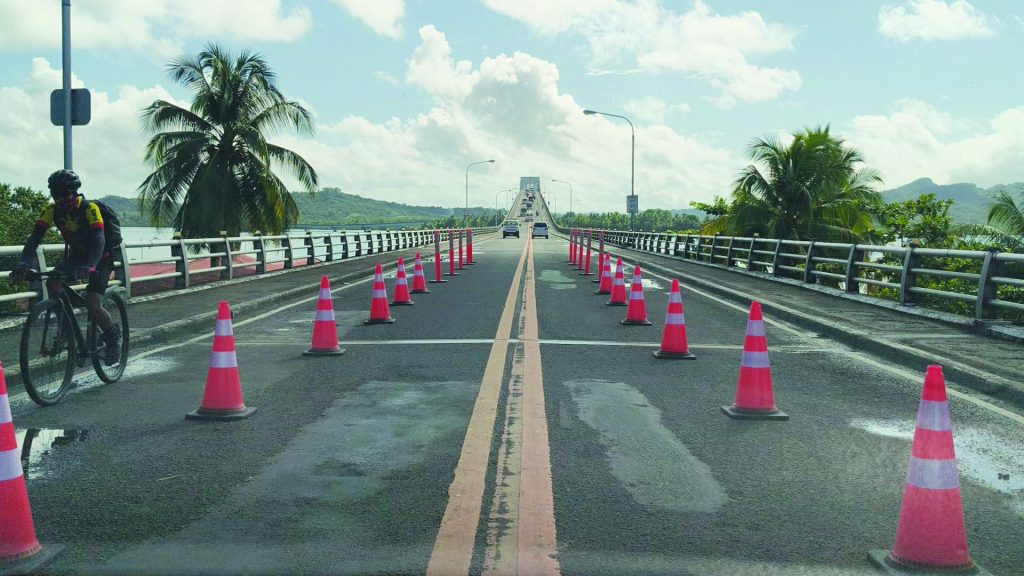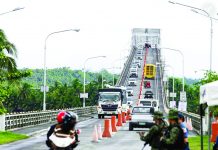EV economy in peril?

TACLOBAN CITY – The imposition of a 3-ton weight limit on the iconic San Juanico Bridge is triggering a ripple effect of economic disruptions across Eastern Visayas, with projected losses reaching up to P600 million per month, according to business leaders and government officials.
The restriction, enforced by the Department of Public Works and Highways (DPWH) on May 14, was prompted by structural defects found in all 42 spans of the 53-year-old bridge, which connects Leyte and Samar and serves as a vital artery between Luzon, Visayas, and Mindanao.
“The economic losses due to issues with the San Juanico Bridge can be significant, considering its role as a critical inter-island link,” said Wilson Uy, former president of the Philippine Chamber of Commerce and Industry Tacloban-Leyte Inc. and current Leyte First District Board Member.
Uy estimates that the daily economic impact of delayed cargo shipments, increased fuel costs, business interruptions, and tourism declines could reach between P10 million to P20 million per day, translating to P300 million to P600 million monthly.
“Thousands of trucks carrying goods between Mindanao and Luzon use this route. Any closure or serious bottleneck can result in spoiled goods—particularly agricultural products—and rerouting costs that affect the entire supply chain,” he added.
Uy warned that transport costs, now surging due to longer alternate routes, will ultimately be passed on to consumers, increasing the prices of essential goods in Samar, Leyte, and beyond. “The disruption has serious implications for wholesale and retail trade, construction, and manufacturing sectors that rely on imported materials,” he said.
The Department of Tourism (DOT) Region 8 expressed similar concerns.
In a statement issued May 16, Regional Director Karina Rosa Tiopes warned that the restriction will hinder the movement of tourists, especially those traveling in buses and large vans, which are now prohibited from crossing the bridge.
“The sudden imposition of a strict weight limit will likely have a significant and multifaceted impact on the tourism industry,” Tiopes said, citing longer, costlier, and less convenient alternate routes as deterrents for tourists.
Eastern Visayas welcomed 1.6 million tourists in 2023, generating P39.33 billion in revenues. In the first quarter of 2025 alone, over 300,000 tourists visited the region, with receipts exceeding P1.77 billion—a momentum now at risk.
The growing crisis has prompted government agencies and business groups to appeal to the national government to expedite the bridge’s P900-million rehabilitation, which is expected to take two years.
The Samar Provincial Disaster Risk Reduction and Management Council (PDRRMC), led by Governor Sharee Ann Tan, has recommended declaring a state of emergency in the province.
A separate resolution was passed requesting the Philippine Navy to provide vessels for transporting fuel, medical supplies, and essential goods between Tacloban and Catbalogan.
The Regional Disaster Risk Reduction and Management Council (RDRRMC) has raised a blue alert status across Eastern Visayas, placing at least 50% of emergency personnel on standby to manage traffic flow, support logistics, and assist stranded travelers.
The Department of Social Welfare and Development (DSWD) has established a Mobile Command Center and is deploying mobile kitchens to provide hot meals to affected passengers at key choke points.
Meanwhile, private shipping companies have started offering expanded Roll-on/Roll-off (RoRo) routes to accommodate vehicles over the 3-ton limit. The Maritime Industry Authority (MARINA) has pledged to expedite permits for RoRo operators to ensure smoother cargo and passenger movement.
Uy stressed that while the economic impact figures are still conservative estimates, they underscore the urgency of immediate national intervention.
“This is no longer just a local inconvenience. The implications stretch across the supply chain from Mindanao to Luzon. The San Juanico Bridge may be symbolic, but right now, it is a very real economic lifeline,” he said.
RONALD O. REYES. ROEL T. AMAZONA, LIZBETH ANN A. ABELLA



